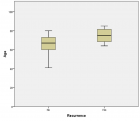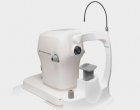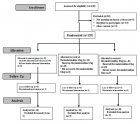Abstract
Review Article
The Role of Genetic Mutations in the HPGD & SLCO2A1 Genes in Pachydermoperiostosis Syndrome
Shahin Asadi*, Arezo Zare and Sima Koohestani
Published: 01 May, 2025 | Volume 8 - Issue 1 | Pages: 001-005
Pachydermoperiostosis, also known as Primary Hypertrophic Osteoarthropathy (PHO), is a rare genetic disorder. The three main features are: enlarged fingertips (clubbing), thickened facial skin (pachydermia), and excessive sweating (hyperhidrosis). PHO is characterized by problems with skin and bone growth. Patients with PHO usually have coarse facial features with oily, thick, grooved skin on the face, joint pain, enlarged fingertips and toes, and hyperhidrosis of the hands and feet. Symptoms vary individually; however, men generally present with more severe manifestations. X-rays can help check for features that are not noticeable to the naked eye. There are two genes that are associated with PHO: the HPGD gene, located on the long arm of chromosome 4 at 4q34.1, and the SLCO2A1 gene, located on the long arm of chromosome 3 at 3q22.1 - q22.2. Mutations in the HPGD gene are inherited in an autosomal recessive manner, and the condition is sometimes abbreviated as PHOAR1 or Touraine-Solente-Gole syndrome.
Read Full Article HTML DOI: 10.29328/journal.jgmgt.1001013 Cite this Article Read Full Article PDF
Keywords:
Pachydermoperiostosis syndrome; Genetic disorder; Mutated genes; HPGD gene; SLCO2A1 gene
References
- Asadi S, Jamali M, Bagheri R, Dell SS. Pathology in Medical Genetic Books. Vol. 21 & 22. Iran: Amidi Publications; 2025. Available from: https://www.researchgate.net/publication/316861684_PATHOLOGY_IN_MEDICAL_GENETICS_2_M-Z
- Fauci AS, Braunwald E, Isselbacher KJ. editors. Harrison’s Principles of Internal Medicine. 20th ed. New York (NY): McGraw-Hill Companies. 2018.
- Griffiths C, Barker J, Bieiker T. Rook’s Textbook of Dermatology. 9th ed. London (UK): Wiley Blackwell Scientific Publications. 2016.
- Xu Y, Zhang Z, Yue H, Li S, Zhang Z. Monoallelic mutations in SLCO2A1 cause autosomal dominant primary hypertrophic osteoarthropathy. J Bone Miner Res. 2021;36(8):1459-68. Available from: https://www.researchgate.net/publication/352569346
- Marques P, Stelmachowska-Banas M, Collier D, Wernig F, Korbonits M. Pachydermoperiostosis mimicking the acral abnormalities of acromegaly. Endocrine. 2020;67(2):499–500. Available from: https://www.ncbi.nlm.nih.gov/pmc/articles/PMC7033267/
- Joshi A, Nepal G, Shing YK, Panthi HP, Baral S. Pachydermoperiostosis (Touraine–Solente–Gole syndrome): a case report. J Med Case Reports. 2019;13:39. Available from: https://www.ncbi.nlm.nih.gov/pmc/articles/PMC6362496/
- Yuan L, Liao RX, Lin YY, Jiang Y, Wang O, Li M, et al. Safety and efficacy of cyclooxygenase-2 inhibition for treatment of primary hypertrophic osteoarthropathy: a single-arm intervention trial. J Orthop Translat. 2019;18:109-18. Available from: https://www.ncbi.nlm.nih.gov/pmc/articles/PMC6546478/
- Primary hypertrophic osteoarthropathy related gastrointestinal complication has distinctive clinical and pathological characteristics: two cases report and review of the literature. Orphanet J Rare Dis. 2019;14:297. Available from: https://www.ncbi.nlm.nih.gov/pmc/articles/PMC6828001/
- Yuan L, Chen X, Liu Z, Wu D, Lu J, Bao G, et al. Novel SLCO2A1 mutations cause gender-differentiated pachydermoperiostosis. Endocr Connect. 2018;7(11):116-28. Available from: https://www.ncbi.nlm.nih.gov/pmc/articles/PMC6231361/
- Li SS, He JW, Fu WZ, Liu YJ, Hu YQ, Zhang ZL. Clinical, biochemical, and genetic features of 41 Han Chinese families with primary hypertrophic osteoarthropathy, and their therapeutic response to etoricoxib: results from a six-month prospective clinical intervention. J Bone Miner Res. 2017;32(8):1659-66. Available from: https://www.ncbi.nlm.nih.gov/pmc/articles/PMC5539869/
- Lee S, Park SY, Kwon HJ, Lee CH, Kim OH, Rhee Y. Identification of the mutations in the prostaglandin transporter gene, SLCO2A1 and clinical characterization in Korean patients with pachydermoperiostosis. J Korean Med Sci. 2016;31(5):735-42. Available from: https://doi.org/10.3346/jkms.2016.31.5.735
- Zhang Z, He JW, Fu WZ, Zhang CQ, Zhang ZL. Mutations in the SLCO2A1 gene and primary hypertrophic osteoarthropathy: a clinical and biochemical characterization. J Clin Endocrinol Metab. 2013;98(5):E923-E933. Available from: https://doi.org/10.1210/jc.2012-3568
- Hamosh A, Scott AF, Amberger J, Valle D, McKusick VA. Online Mendelian Inheritance in Man (OMIM). Hum Mutat. 2000;15(1):57-61. Available from: https://doi.org/10.1002/(sici)1098-1004(200001)15:1%3C57::aid-humu12%3E3.0.co;2-g
- Medscape. 2021. Available from: https://emedicine.medscape.com/article/1075122-overview
- Pachydermoperiostosis. Orphanet. 2011. Available from: https://www.orpha.net/en/disease/detail/2796
Figures:

Figure 1
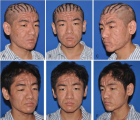
Figure 2
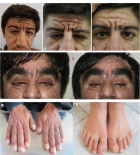
Figure 3

Figure 4

Figure 5
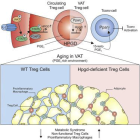
Figure 6
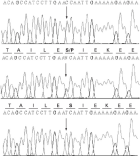
Figure 7
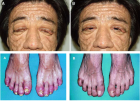
Figure 8
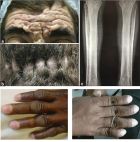
Figure 9

Figure 10
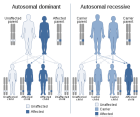
Figure 11

Figure 12

Figure 13
Similar Articles
-
The role of genetic mutations in genes LMNA, PPARG, PLIN1, AKT2, CIDEC in Köbberling–Dunnigan SyndromeShahin Asadi*,Mahsa Jamali. The role of genetic mutations in genes LMNA, PPARG, PLIN1, AKT2, CIDEC in Köbberling–Dunnigan Syndrome. . 2019 doi: 10.29328/journal.jgmgt.1001004; 2: 001-006
-
The Role of Genetic Mutations in the HPGD & SLCO2A1 Genes in Pachydermoperiostosis SyndromeShahin Asadi*,Arezo Zare,Sima Koohestani. The Role of Genetic Mutations in the HPGD & SLCO2A1 Genes in Pachydermoperiostosis Syndrome. . 2025 doi: 10.29328/journal.jgmgt.1001013; 8: 001-005
Recently Viewed
-
A Resurgence of the Idea of Hypertriglyceridemia and Lower Serum (HDL-C) as Predictive Factors for Insulin Resistance (IR) & Type 2 Diabetes Mellitus Development: A Narrative ReviewKulvinder Kochar Kaur*. A Resurgence of the Idea of Hypertriglyceridemia and Lower Serum (HDL-C) as Predictive Factors for Insulin Resistance (IR) & Type 2 Diabetes Mellitus Development: A Narrative Review. New Insights Obes Gene Beyond. 2025: doi: 10.29328/journal.niogb.1001022; 9: 001-012
-
Novel Mutation in Famous Gene Diseases in Red Blood CellsMahdi Nowroozi*. Novel Mutation in Famous Gene Diseases in Red Blood Cells. New Insights Obes Gene Beyond. 2025: doi: 10.29328/journal.niogb.1001023; 9: 013-020
-
Physical Performance in the Overweight/Obesity Children Evaluation and RehabilitationCristina Popescu, Mircea-Sebastian Șerbănescu, Gigi Calin*, Magdalena Rodica Trăistaru. Physical Performance in the Overweight/Obesity Children Evaluation and Rehabilitation. Ann Clin Endocrinol Metabol. 2024: doi: 10.29328/journal.acem.1001030; 8: 004-012
-
The Role of Genetic Mutations in the HPGD & SLCO2A1 Genes in Pachydermoperiostosis SyndromeShahin Asadi*,Arezo Zare,Sima Koohestani. The Role of Genetic Mutations in the HPGD & SLCO2A1 Genes in Pachydermoperiostosis Syndrome. J Genet Med Gene Ther. 2025: doi: 10.29328/journal.jgmgt.1001013; 8: 001-005
-
Estimation of Radiation Dose to Blood Vessels and Components from Medical Imaging Procedures: Current StatusKhalid M Aloufi*. Estimation of Radiation Dose to Blood Vessels and Components from Medical Imaging Procedures: Current Status. Arch Vas Med. 2025: doi: 10.29328/journal.avm.1001020; 9: 001-002
Most Viewed
-
Causal Link between Human Blood Metabolites and Asthma: An Investigation Using Mendelian RandomizationYong-Qing Zhu, Xiao-Yan Meng, Jing-Hua Yang*. Causal Link between Human Blood Metabolites and Asthma: An Investigation Using Mendelian Randomization. Arch Asthma Allergy Immunol. 2023 doi: 10.29328/journal.aaai.1001032; 7: 012-022
-
Impact of Latex Sensitization on Asthma and Rhinitis Progression: A Study at Abidjan-Cocody University Hospital - Côte d’Ivoire (Progression of Asthma and Rhinitis related to Latex Sensitization)Dasse Sery Romuald*, KL Siransy, N Koffi, RO Yeboah, EK Nguessan, HA Adou, VP Goran-Kouacou, AU Assi, JY Seri, S Moussa, D Oura, CL Memel, H Koya, E Atoukoula. Impact of Latex Sensitization on Asthma and Rhinitis Progression: A Study at Abidjan-Cocody University Hospital - Côte d’Ivoire (Progression of Asthma and Rhinitis related to Latex Sensitization). Arch Asthma Allergy Immunol. 2024 doi: 10.29328/journal.aaai.1001035; 8: 007-012
-
An algorithm to safely manage oral food challenge in an office-based setting for children with multiple food allergiesNathalie Cottel,Aïcha Dieme,Véronique Orcel,Yannick Chantran,Mélisande Bourgoin-Heck,Jocelyne Just. An algorithm to safely manage oral food challenge in an office-based setting for children with multiple food allergies. Arch Asthma Allergy Immunol. 2021 doi: 10.29328/journal.aaai.1001027; 5: 030-037
-
Snow white: an allergic girl?Oreste Vittore Brenna*. Snow white: an allergic girl?. Arch Asthma Allergy Immunol. 2022 doi: 10.29328/journal.aaai.1001029; 6: 001-002
-
Cytokine intoxication as a model of cell apoptosis and predict of schizophrenia - like affective disordersElena Viktorovna Drozdova*. Cytokine intoxication as a model of cell apoptosis and predict of schizophrenia - like affective disorders. Arch Asthma Allergy Immunol. 2021 doi: 10.29328/journal.aaai.1001028; 5: 038-040

If you are already a member of our network and need to keep track of any developments regarding a question you have already submitted, click "take me to my Query."







